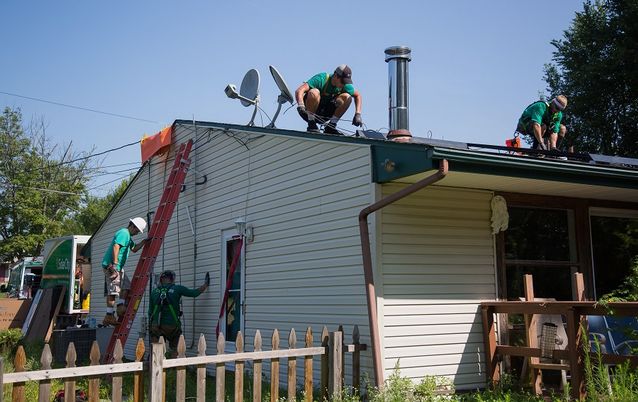Solar power takes off in California with third parties leasing panels cheaply
by Mark Chediak,
2015-12-15 06:12:42.0
SILICON Valley has something to offer the world in the drive towards a clean energy economy. It’s not technology. It’s a financing formula.
In a region that spawned tech giants including Apple and Google, a handful of start-ups began offering to install solar panels on the homes of middle-class families in return for no-money down and monthly payments cheaper than a utility bill.
This third-party leasing method that made expensive clean energy gear affordable, has ignited a rooftop solar revolution with annual US home installations increasing sixteenfold since 2008, according to the Solar Energy Industries Association and GTM Research.
The world is taking notice. Businesses in China, the biggest greenhouse-gas polluter, are so keen on replicating California’s success that Trina Solar head of global marketing Jing Tian says she had to come up with a rough Chinese translation for "third-party leasing".
Similar models are spreading to countries such as Mexico and Japan and are being employed to sell other emerging clean energy technologies such as batteries and onsite waste-water treatment gear.
"There is a reason why California is a tech Mecca for the world, because the infrastructure is here to attract that talent," says SolarCity CEO Lyndon Rive, whose company popularised third-party solar leases for homeowners, starting in 2008.
"All the major innovation is going to occur in California. One of the innovations is the financing of solar assets," he says.
One thing world leaders seemed to agree on at climate-change talks that concluded in Paris this past weekend is that renewable energy resources, including solar, are critical to efforts in curbing global warming.
The International Energy Agency has said that renewable energy investment in the power sector needs to increaseto $400bn in 2030 from $270bn last year.
Under a solar lease, a homeowner can have a rooftop solar power system installed for little or no money. Instead, they pay the developer for the output that the panels produce over 15 or 20 years, at a price that’s usually lower than the local utility charges.
SolarCity took the leasing model first developed for the solar industry by a graduate student and SunEdison founder, Jigar Shah. SunEdison entered into its first power purchase agreement with Whole Foods Market in 2003, according to Shah’s book, Creating Climate Wealth.
SolarCity adapted that model for residential consumers in 2008 and many more offered similar arrangements including Sunrun, which developed the first one in 2007, and Vivint Solar. In August, SolarCity bought a developer in Mexico that was offering the first leases to businesses in that country.
The idea is spreading to other industries trying to sell expensive capital equipment that reduce pollution and fossil fuel consumption.
Cambrian Innovation, a start-up spun out of Massachusetts Institute of Technology, has developed onsite wastewater treatment plants. While the high cost makes such plants difficult to sell, when they combine all the benefits to a consumer such as a brewery — lower disposal fees, water use, energy use and carbon emissions — the company can finance leases and offer savings at no cost to the consumer.
"SunEdison developed the solar power-as-a-service that helped the industry take off," says Cambrian CEO Matthew Silver.
"Now we’re offering clean water as a service that municipal utilities can’t or won’t do."
Bloomberg

SolarCity employees install solar panels on the roof of a home in Kendall Park, New Jersey, the US. Picture: BLOOMBERG/MICHAEL NAGLE
SILICON Valley has something to offer the world in the drive towards a clean energy economy. It’s not technology. It’s a financing formula.
In a region that spawned tech giants including Apple and Google, a handful of start-ups began offering to install solar panels on the homes of middle-class families in return for no-money down and monthly payments cheaper than a utility bill.
This third-party leasing method that made expensive clean energy gear affordable, has ignited a rooftop solar revolution with annual US home installations increasing sixteenfold since 2008, according to the Solar Energy Industries Association and GTM Research.
The world is taking notice. Businesses in China, the biggest greenhouse-gas polluter, are so keen on replicating California’s success that Trina Solar head of global marketing Jing Tian says she had to come up with a rough Chinese translation for "third-party leasing".
Similar models are spreading to countries such as Mexico and Japan and are being employed to sell other emerging clean energy technologies such as batteries and onsite waste-water treatment gear.
"There is a reason why California is a tech Mecca for the world, because the infrastructure is here to attract that talent," says SolarCity CEO Lyndon Rive, whose company popularised third-party solar leases for homeowners, starting in 2008.
"All the major innovation is going to occur in California. One of the innovations is the financing of solar assets," he says.
One thing world leaders seemed to agree on at climate-change talks that concluded in Paris this past weekend is that renewable energy resources, including solar, are critical to efforts in curbing global warming.
The International Energy Agency has said that renewable energy investment in the power sector needs to increaseto $400bn in 2030 from $270bn last year.
Under a solar lease, a homeowner can have a rooftop solar power system installed for little or no money. Instead, they pay the developer for the output that the panels produce over 15 or 20 years, at a price that’s usually lower than the local utility charges.
SolarCity took the leasing model first developed for the solar industry by a graduate student and SunEdison founder, Jigar Shah. SunEdison entered into its first power purchase agreement with Whole Foods Market in 2003, according to Shah’s book, Creating Climate Wealth.
SolarCity adapted that model for residential consumers in 2008 and many more offered similar arrangements including Sunrun, which developed the first one in 2007, and Vivint Solar. In August, SolarCity bought a developer in Mexico that was offering the first leases to businesses in that country.
The idea is spreading to other industries trying to sell expensive capital equipment that reduce pollution and fossil fuel consumption.
Cambrian Innovation, a start-up spun out of Massachusetts Institute of Technology, has developed onsite wastewater treatment plants. While the high cost makes such plants difficult to sell, when they combine all the benefits to a consumer such as a brewery — lower disposal fees, water use, energy use and carbon emissions — the company can finance leases and offer savings at no cost to the consumer.
"SunEdison developed the solar power-as-a-service that helped the industry take off," says Cambrian CEO Matthew Silver.
"Now we’re offering clean water as a service that municipal utilities can’t or won’t do."
Bloomberg





















Change: 0.74%
Change: 0.82%
Change: 2.06%
Change: 0.64%
Change: 0.11%
Data supplied by Profile Data
Change: 1.07%
Change: 0.72%
Change: 0.74%
Change: 0.00%
Change: 0.78%
Data supplied by Profile Data
Change: -1.10%
Change: -1.13%
Change: -1.43%
Change: -1.56%
Change: -0.35%
Data supplied by Profile Data
Change: -0.49%
Change: 0.76%
Change: 0.65%
Change: 3.75%
Change: 2.56%
Data supplied by Profile Data